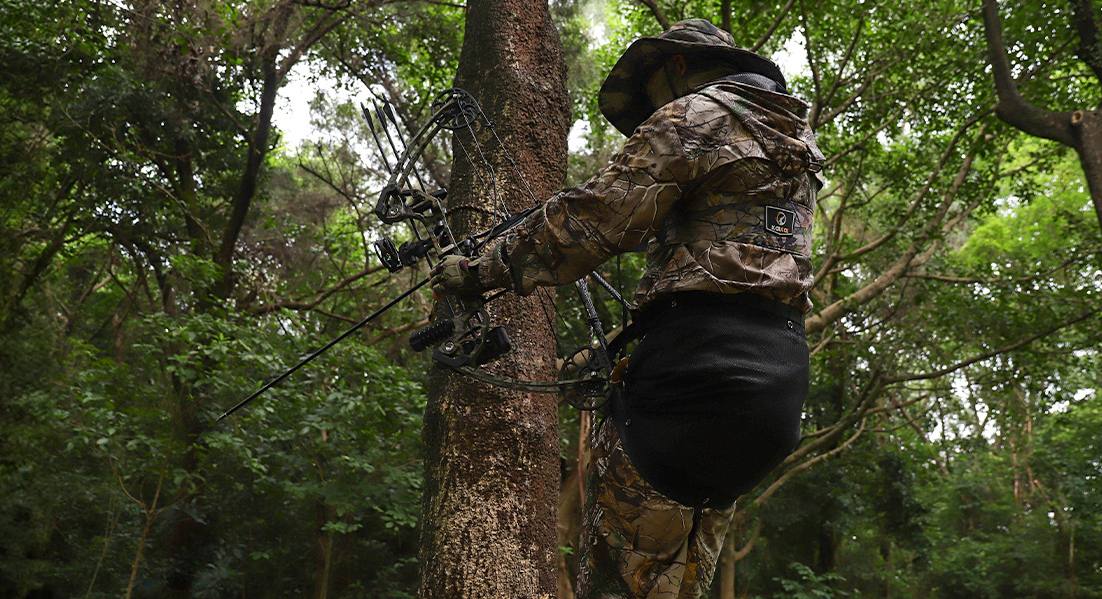In the evolving world of mobile deer hunting, saddle hunting has exploded in popularity—and for good reason. With its ultra-lightweight design, minimal impact on the woods, and flexibility in the tree, it’s become a go-to method for serious whitetail hunters who prioritize stealth, mobility, and versatility.
Whether you’re brand new to saddle hunting or just trying to sharpen your system, this guide will walk you through the pros and cons, how to set up, and key safety tips to help you make the most of your saddle-hunting experience.
🎯 What is Saddle Hunting?
Saddle hunting involves using a hunting saddle—a fabric seat that wraps around your waist and upper legs—suspended from a tree tether to allow you to hang off the side of a tree and shoot 360 degrees around the trunk. Instead of sitting on a treestand platform, you hang from the tree, often with your feet resting on a small platform or climbing stick step.
The key advantages? You can pack in light, get in fast, and stay deadly quiet.
✅ Pros of Saddle Hunting
1. Ultimate Mobility
Saddle setups typically weigh under 10–12 pounds, including climbing sticks, a platform, and the saddle itself. That means:
- Less fatigue during long treks.
- Faster setups in the dark.
- Easier access to remote public land spots.
2. Versatile Tree Selection
Unlike treestands that require a perfectly straight, limbless tree, saddle hunters can:
- Hunt from crooked, gnarly, or multi-trunk trees.
- Blend into more natural cover.
- Stay hidden without trimming branches.
3. 360° Shooting Opportunities
With the right setup and practice, you can shoot all around the tree:
- Use the tree as cover from the deer’s line of sight.
- Lean or pivot for shots on either side.
- Stay more concealed while drawing your bow.
4. Public Land Friendly
Saddles make minimal impact on the woods:
- No need to leave stands overnight.
- Less theft risk.
- More flexibility to change spots based on sign, wind, or pressure.
❌ Cons of Saddle Hunting
1. Steep Learning Curve
There’s no sugarcoating it—saddle hunting requires:
- Practice with rope systems and knots.
- Comfort while hanging for hours.
- Learning how to shoot from new angles and stances.
2. Initial Investment
A full saddle kit (saddle, lineman’s rope, tether, platform, climbing sticks) can run $400–$700+. But once you’re set, you won’t need much else.
3. Comfort is Personal
Some hunters love the saddle feel. Others can’t get used to:
- Pressure on hips or back.
- The “swing” sensation.
- Long sits without a backrest.
Try different brands and setups to find what works for you. Some companies offer adjustable bridge systems, backbands, and knee pads for added comfort.
🛠 Saddle Setup: What You Need
Here’s a basic breakdown of gear for a beginner saddle hunting system:
🪢 1. Hunting Saddle
- The seat that holds your body.
- Look for breathable materials and adjustable leg straps.
🧗 2. Tree Tether
- Your main lifeline.
- Anchors to the tree and supports your weight.
- Often made from 8mm–11mm climbing rope with a prusik or mechanical ascender.
🪢 3. Lineman’s Rope
- Allows you to stay clipped in while climbing.
- Wraps around the tree and connects to your saddle.
🪜 4. Climbing Sticks / Aider
- Aluminum or carbon fiber sticks help you ascend the tree.
- Add a “one-stick” method or aider steps to save weight.
⬛ 5. Platform or Ring of Steps
- Gives your feet support and mobility around the tree.
- Platforms like the Tethrd Predator or Trophyline Wingman are popular options.
🦺 Safety Tips Every Saddle Hunter Should Know
1. Always Use a Lineman’s Rope
From the moment your feet leave the ground, you should be clipped in with either your lineman’s belt or tether.
2. Inspect Your Gear Before Every Hunt
Check ropes for fraying, carabiners for locking integrity, and platforms for cracks or damage.
3. Practice Low Before You Go High
Before you ever hunt 20 feet up:
- Practice at 3–6 feet.
- Simulate drawing and shooting your bow.
- Learn how to manage your lines and maneuver safely.
4. Pack a Backup Plan
Have a rescue plan in case of a fall or gear failure. Keep your cell phone accessible, and consider a suspension trauma strap or emergency descender.
5. Use a Tether Backup (Optional)
Some hunters use a second tether or a backup knot like the Klemheist or autoblock for added security.
🎯 Final Thoughts
Saddle hunting isn’t just a trend—it’s a revolution in mobile hunting. It’s not for everyone, but for hunters who want to stay light, stealthy, and mobile, it offers a whole new level of freedom in the woods.
If you’re willing to put in the practice, dial in your gear, and make safety a priority, saddle hunting can be one of the most effective and enjoyable ways to chase mature deer, especially on pressured public land.
Ready to hang and hunt? The saddle is calling.


